K3b/es: Difference between revisions
Created page with ':* '''Nuevo proyecto de datos''' :* '''Nuevo proyecto de audio''' :* '''Copiar disco'''' |
Created page with ''''K3b''' puede hacer mucho más aparte de estas tareas, y puedes encontrar que algunas de estas otras posibilidades son útiles para ti. Echa un vistazo a esta lista para ver un...' |
||
| Line 28: | Line 28: | ||
:* '''Copiar disco''' | :* '''Copiar disco''' | ||
'''K3b''' | '''K3b''' puede hacer mucho más aparte de estas tareas, y puedes encontrar que algunas de estas otras posibilidades son útiles para ti. Echa un vistazo a esta lista para ver una muestra de las otras funciones disponibles (haz clic en la imagen para ampliarla): | ||
[[Image:K3bMoreActions.png|250px|thumb|center]] | [[Image:K3bMoreActions.png|250px|thumb|center]] | ||
Revision as of 17:12, 5 August 2010
Template:I18n/Language Navigation Bar
¡K3b es un programa simple, potente y muy configurable para la grabación de discos ópticos de audio, vídeo. datos y mucho más!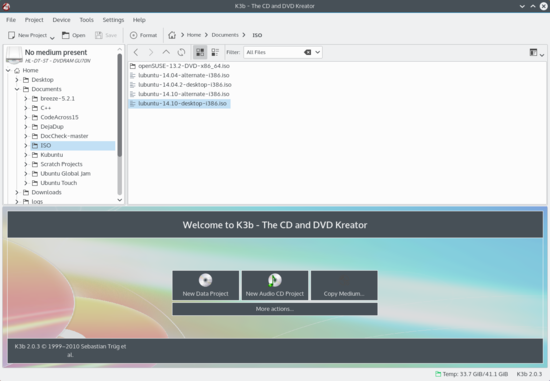 |
Introducción
Si has usado algún programa de grabación como por ejemplo Nero en Windows, K3b te resultará bastante familiar.
K3b proporciona una interfaz gráfica simple pero potente, que permite múltiples opciones para la grabación de CD, DVD, o BD (discos Blu-ray). Están disponibles varios tipos de proyectos como por ejemplo proyectos de datos y audio, proyectos de vídeo para DVD y VCD, así como discos multisesión y discos de modo mixto. K3b también te permite borrar discos regrabables y puede llevar a cabo tareas más complicadas tales como la codificación y decodificación audiovisual.
Configuración previa
Cuando ejecutes K3b por primera vez puede que te informe de que no se han encontrado unidades de grabación, lo que significa que no podrás grabar ningún disco, pero no te asustes porque k3b abrirá una ventana de configuración que te ayudará a configurar y ejecutar varias herramientas. Esto incluye el grupo de usuario que posee estas aplicaciones. No deberías cambiar nada puesto que K3b aplicará los permisos correctos a los programas externos automáticamente (estos programas generalmente son cdrecord, growisofs y cdrdao). Si lo deseas, puedes decirle a K3b que use el grupo de grabación burning y lo asigne a la unidad óptica. Abajo puedes ver una imagen de la ventana de configuración donde aparecen estas opciones.
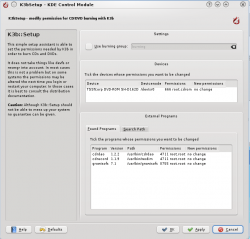
Configurar la Interfaz de usuario
Una vez iniciado K3b se ofrece la posibilidad de iniciar rápidamente uno de los tres proyectos más populares:
- Nuevo proyecto de datos
- Nuevo proyecto de audio
- Copiar disco
K3b puede hacer mucho más aparte de estas tareas, y puedes encontrar que algunas de estas otras posibilidades son útiles para ti. Echa un vistazo a esta lista para ver una muestra de las otras funciones disponibles (haz clic en la imagen para ampliarla):
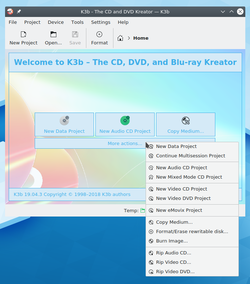
Perhaps a quick start for one or more of these other tasks would be useful to you and so K3b can give you that, too. Simply right click on the application desktop, and here you will see a menu for adding buttons:
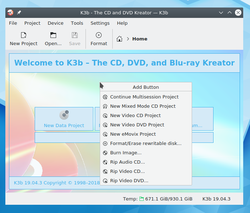
Configuring the internals
Most of the default settings can simply be left alone. It is however, recommended that you do take a look at the Advanced Settings page. Here you can set various important settings, if required.
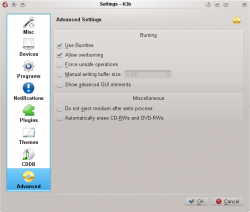
- Use Burnfree should be set - it controls the burn, ensuring that the buffer never gets dangerously low (which reduces the quantity of bad burns).
- You may wish to automatically erase re-writable disks.
- The option Do not eject medium after write process is invaluable if your drive is one that cannot be closed quickly enough for Verify to happen.
Preparing to burn a disk
When starting a new project, you should ensure that K3b has detected the correct optical media, such as CD or DVD. On the status line at the bottom of the screen you should see the size of disk which is currently set. If this is not correct, or you require a different size, simply right-click on it and set the preferred size from the provided list:
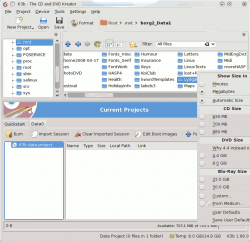
All that's left to do now, is choose what is to be burned. The top half of the screen functions like a file manager. Simply drag and drop the files and directories you wish to burn onto the large pane at bottom right. On the left you will see a tree view forming of your chosen files. Should there be some files or directories which you do not want to burn, these can be easily removed from the project by simply removing them from the panel at the bottom. Select the file to be removed (you can control-click to select multiple ones), then right-click, and select Remove. After this, the bottom left-hand panel should show an updated tree representation of the directories and files.
The top line will be the title of the disk. In many cases this will be fine, but if you would like to change this to something else, simply right-click on the title and rename it.
Final Steps
You are now ready to hit the Burn button.
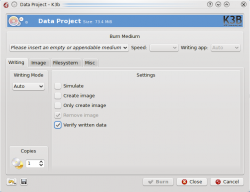
You will see on my screenshot that no disk was present. When you have inserted the appropriate disk you will see a description of it on that line.
There are still one or two choices to be made. I would recommend that you set Verify written data, then hit the Save icon at the bottom of the screen, ensuring that it becomes your personal default. For most modern drives it's safe to leave mode and speed to Auto. If you may wish to burn another copy of the disk at a later date, select Create image, which will save having to set up the burn again. Set the number of copies you want to burn, then, when you are satisfied, hit Burn.
Burning an Audio CD
This page tells you how to burn an audio CD from your stored files.
